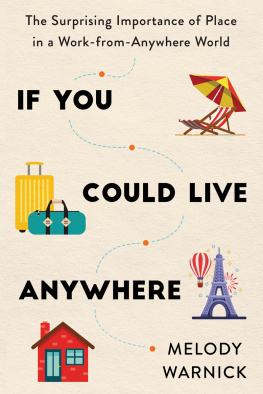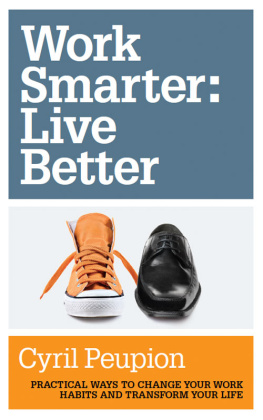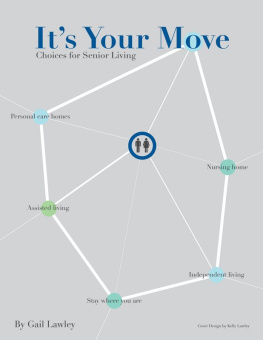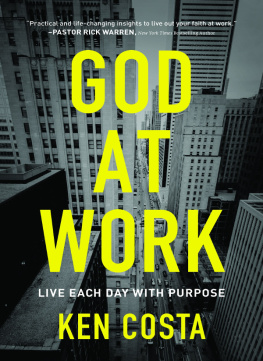Thank you for downloading this Sourcebooks eBook !
You are just one click away from
Being the first to hear about author happenings
VIP deals and steals
Exclusive giveaways
Free bonus content
Early access to interactive activities
Sneak peeks at our newest titles
Happy reading !
CLICK HERE TO SIGN UP
Books . Change . Lives .
Thank you for reading this Sourcebooks eBook !
Join our mailing list to stay in the know and receive special offers and bonus content on your favorite books and authors!
CLICK HERE TO SIGN UP
Books . Change . Lives .
1
WHEN ANYWHEREISTS
RULE THE WORLD
The seven-year period that Amy and James Hebdon lived and worked in the Seattle area is longer than a lot of things. The Civil War, for instance. The number of years Lost was on the air. Just not long enough for the Hebdons to feel like they were ever more than temporary residents biding their time there.
It wasnt that they didnt like Seattle. They both adored the luxury apartment they rented in Kirkland, one of Seattles upscale eastern suburbs. James was the rare breed of human who actually prefers Pacific Northweststyle dreary weather. But the city, they knew, could never give them the kind of life they imagined for themselvesone where kids and dogs caromed over a few rural acres, basement shelves displayed gleaming mason jars full of produce they canned themselves, and chickens scratched in the side yard.
Amy desperately wanted to buy a house, but by 2016, Seattle home prices had soared to astronomical levels. The house Jamess sister bought there cost $1 million. There was no version of the Seattle multiverse where Amy and James could afford anything like that. I wanted to be able to have a place that was ours, where we could settle down and have a home, said Amy. Its hard to ever feel quite settled if you have in the back of your mind that this isnt going to last.
Luckily, Amy and James had a secret weapon: they were location independent.
For nearly ten years, Amy had been a mostly remote worker, sometimes as a full-time W2 employee, sometimes as an independent contractor. But in 2017, she quit her job at a Seattle tech company to start her own digital marketing firm, and soon after, James joined her in the business. Within a few months, they were earning six figures in revenue. Their clients had no idea that they worked out of their house.
With the kinds of jobs they could do anywhere that offered a decent internet connection, they quickly realized they werent limited just to working out of their Kirkland apartment. Why not a coffee shop or a coworking space? A national park campground? A South American beach? If they could work from anywhere, then the corollary was automatically true: they could live anywhere too. Like thousands of similarly location-independent humans, they began asking themselves this life-changing question: If we can work anywhere, where should we live?
Amy and James are what I call Anywhereists, members of a fast-growing subset of people who arent tied to a particular geography by what they do for a living. Corporate relocations, soul-crushing commutes to urban offices, living somewhere youre not really that fond ofwhen youre an Anywhereist, all those concerns slide off the table. Being free to work anywhere lets you make your own choices about where your life is going to play out.
Perhaps youre an Anywhereist tooor want to be.
Maybe, like Amy and James, youve started your own business in part to provide yourself some location flexibility.
Maybe youre a remote worker who puts in a nine to five with a company that doesnt demand your physical presence every day. Someone like Ryan Mita, a business-to-business (B2B) sales rep who used his COVID-19 remote status to move from New York City to Austin, Texas, just because he could.
Maybe youre a solopreneur like Grace Taylor, an accountant who runs her business anywhere she happens to be (and caters to clients who are digital nomads like she is).
Maybe, like an estimated 35 percent of the American workforce,
Maybe youre semiretired like Ria Talken, who left Oakland for San Miguel de Allende, Mexico, which has 320 days of annual sunshine. Or youre just flat-out done with paid work, perhaps because you hustled to retire early, and now youre looking to make all your place fantasies come true.
Whatever gets you to Anywhereism, heres the uniting factor: because your work exists where you are, you have a higher-than-average level of autonomy to decide where you want to live. Anywhereism isnt solely about the where of life either. Tied up in location independence is the freedom and flexibility to design how you want to livewhat you value, what kinds of experiences you want to have, what success really means to you. (Hint: It probably isnt whatever gold star you get for putting in seventy-hour workweeks.)
Becoming an Anywhereist can be the antidote for the modern economys epidemic levels of burnout, exhaustion, and stress, or in the words of writer Anne Helen Petersen, the feeling that youve optimized yourself into a work robot. Anywhereists work hard, but they also want to have a well-adjusted relationship with their time, energy, mental health, physical wellness, friends and family, leisure, and goals. To do all that, they often take control of their location first.
HOW TO BE AN ANYWHEREIST
Anywhereism isnt exactly new, but its gained steam in the past two decades. Back in 2007, Tim Ferriss touted the idea of location independence in his massive bestseller The 4-Hour Workweek. Those cartoony palm trees on the cover beckoned millions of readersentrepreneurs, freelancers, and anyone ground down by their nine to fiveto fantasize about a sun-soaked life working on the beach while a margarita sweated in the sand nearby.
Entire companies soon climbed aboard the work-from-anywhere train. At web design and software company Basecamp, founders Jason Fried and David Heinemeier Hansson raved about their totally distributed team, with employees scattered from Copenhagen to Caldwell, Idaho. Great talent is everywhere, and not everyone wants to move to San Francisco (or New York or Hollywood, or wherever youre headquartered), they wrote in a 2013 guide called Remote: Office Not Required. Remote work is about setting your team free to be the best it can be, wherever that might be.
The internet acted like a chemical spill, slowly dissolving the ties linking workplaces with physical spaces. Between 2009 and 2019, the number of location-independent workers grew by 140 percent.
Naturally, not everyone was a fan. Asking a Google spokesperson whether the tech company permitted employees to telecommute, Nikil Saval, author of the 2014 book Cubed: A Secret History of the Workplace, received this clipped response: Noand we discourage it.
But the genie couldnt be put back in the bottle. Work-from-anywhere existed in the world, and millennials and Gen Z in particular wanted it so badly that they were willing to change jobs or give up vacation time to have it. For 77 percent of job seekers deciding between offer A and offer B, remote work is the perk that would tip the scales.
Then came the COVID-19 pandemic, which no one has to tell you poured lighter fluid on the idea of Anywhereism. In March 2020, when office spaces around the world shut their doors in an attempt to slow the spread of the coronavirus, about 175 million Americans instantly shifted to doing their jobs remotely from couches and IKEA desks at home. According to a University of Oxford analysis, more than half of the American workforce held one of the 113 occupations that could reasonably be performed remotely, so work, like Celine Dions heart, went on, even during a global pandemic. As potted plants withered on cubicle shelves and tuna fish sandwiches moldered in office kitchens, employees clacked away at their laptops at home and finally figured out how to use Slack with their coworkers.
Next page










